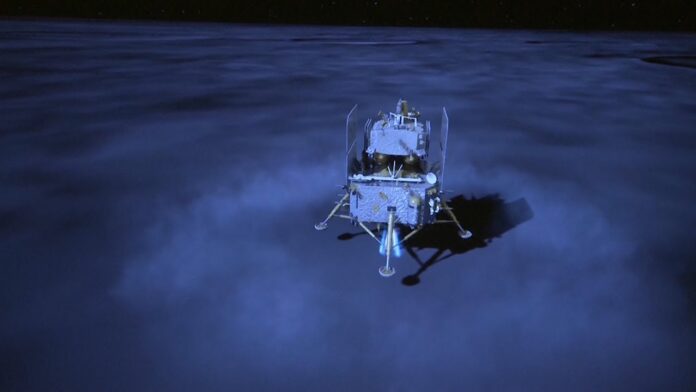The Chinese lunar probe successfully touches down in the South Pole-Aitken basin, collecting samples to understand the moon’s far side
China achieved a major milestone in space exploration with the successful landing of its Chang’e-6 spacecraft on the far side of the moon. The probe, named after the mythical Chinese moon goddess, touched down at approximately 6:30 a.m. Beijing time on Sunday in the South Pole-Aitken Basin, a vast crater on the lunar surface.
This mission marks China’s continued progress in space exploration, positioning it as a significant player in the 21st-century space race. The Chang’e-6 mission aims to collect rock and soil samples from the moon’s far side, an area less explored compared to the near side. The collected samples are expected to provide valuable insights into the geological differences between the two regions.
The China National Space Administration (CNSA) highlighted the mission’s complexity and the innovative engineering solutions required for its success. “The payloads carried by the Chang’e-6 lander will work as planned and carry out scientific exploration missions,” CNSA stated. The lander, equipped with a small robotic shovel and drill, will collect approximately four pounds of lunar surface material. This material will be launched into lunar orbit using a small rocket booster and retrieved by an orbiting spacecraft.
No other country has managed to land a probe on the far side of the moon, making Chang’e-6 a pioneering mission in lunar exploration. This achievement underscores the significant challenges posed by the moon’s far side, including communication difficulties and its rugged, cratered terrain.
The Chang’e-6 probe was launched early last month, with the mission expected to continue for about another month. This landing follows two other lunar missions this year: one by a Japanese spacecraft and another by U.S. startup Intuitive Machines. However, China’s latest achievement highlights its rapid advancements in space capabilities.
This mission represents China’s sixth lunar exploration endeavour, reflecting its substantial investment in space technology. In addition to lunar missions, China operates its own crewed space station, standing as a rival to the International Space Station. The country has also announced plans to send astronauts to the moon by 2030, aiming to become the second nation to achieve this feat after the United States.
NASA has its eyes set on returning to the moon, with the Artemis missions scheduled to begin as early as 2026. These missions will involve extensive collaboration with private space companies and international space agencies from Canada, Europe, and Japan.
Meanwhile, Boeing’s Starliner program, representing the company’s initial venture into private spaceflight, has experienced repeated delays. The program is striving to launch its first spacecraft this month, reflecting the ongoing challenges in the competitive space sector.
China’s successful landing of the Chang’e-6 on the moon’s far side not only demonstrates its growing prowess in space exploration but also signifies a significant step towards further lunar and possibly interplanetary exploration.
Analysis:
China’s successful landing of the Chang’e-6 spacecraft on the far side of the moon carries several significant implications across various dimensions. From a geopolitical perspective, this achievement underscores China’s rising influence in space exploration, challenging the dominance historically held by the United States and Russia. This event signals a potential shift in the balance of power within the domain of space technology and exploration.
Economically, China’s investment in space technology represents a strategic effort to enhance its technological capabilities and stimulate innovation. The advancements made through the Chang’e-6 mission could lead to commercial opportunities, such as lunar mining and the development of new technologies that could have broader applications on Earth. This mission may also inspire increased private investment in China’s burgeoning space industry, fostering economic growth and technological advancement.
From a sociological standpoint, China’s lunar missions can foster national pride and inspire future generations to pursue careers in science, technology, engineering, and mathematics (STEM). The achievements of the Chang’e-6 mission are likely to be celebrated domestically, contributing to a sense of national unity and achievement.
On the local front, the successful landing highlights the importance of international collaboration in space exploration. Despite geopolitical tensions, the scientific community benefits from shared knowledge and expertise. This mission, like others, could pave the way for future collaborative efforts that transcend national boundaries.
Considering gender and race perspectives, the inclusion of diverse talent in China’s space program could serve as a model for inclusivity in STEM fields globally. Highlighting the contributions of female scientists and engineers in such high-profile missions can inspire young women and minorities to pursue careers in these areas.
The exploration of the moon’s far side also holds theoretical implications for our understanding of lunar and planetary science. The collected samples may provide new insights into the moon’s formation and geological history, potentially reshaping scientific theories and leading to further exploratory missions.
Overall, the Chang’e-6 mission represents a multifaceted achievement with wide-ranging implications. It reflects China’s growing capabilities in space exploration, offers economic and sociological benefits, and contributes to the global body of scientific knowledge
